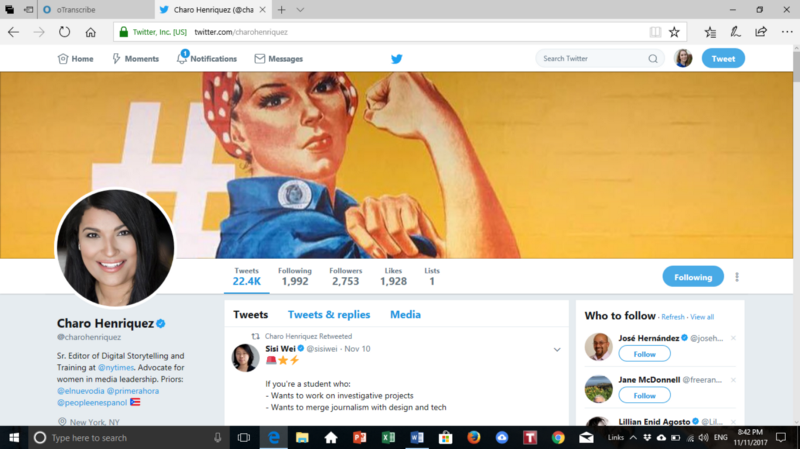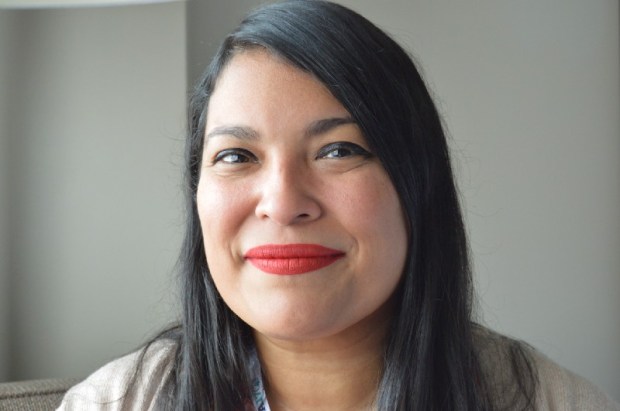November 14, 2017
Originally published on the Reynolds Media Lab.
Natalie Van Hoozer recently caught up with senior editor of digital storytelling and training at the New York Times Charo Henriquez at ONA 2017.
Note: This interview was translated from Spanish and has been edited for clarity and conciseness.
Q: What was your motivation to start a career in journalism?
I didn’t know that I wanted to be a journalist. Even when I was little, I really liked to write and thought that I’d be a writer. When I was looking at higher education possibilities for university, I thought of journalism. When I went to college, there wasn’t digital journalism, so radio, film and television broadcasting interested me. I was also interested in print journalism, so I did a double major at the Universidad del Sagrado Corazón in Puerto Rico and in a way I created a multimedia degree before there was one, one part in journalism and the other part in telecommunications. After that, I started to see how someone can tell stories with various formats in various mediums.

Throughout her career, Henriquez has bridged English and Spanish language media.
Q: Do you think we are lacking bilingual journalists in the United States?
I think that it is very necessary to have bilingual journalists in the United States, in particular Spanish-speaking journalists, because in our case our communities have many stories that have to do with things that are cultural, political, and social that affect the Hispanic communities, and reporting in English isn’t always the way to get to those stories.
Spanish speakers also have an additional responsibility regarding the topic of immigration, where a lot of community stories are not told due to the fear people have of identifying themselves, the fear of reprisal, or fear because of their immigration status. When a person talks to our community in our own language, the resistance lessens a little and the barriers lower a bit, and that person is able to get stories and reach people that can’t necessarily be reached in English because people are wary and they resist telling their stories. When someone tries to tell these stories in English, it’s not as easy.
Q: Do you have an opinion about translating journalism content, as opposed to reporting in the original language?
Of course. When you translate content, you lose a bit of the essence of what is said. You can capture the facts or you can capture the idea of what is being said, but when someone is talking and telling a story in their native language, it has a different color, a different feeling, a different emotion.
Q: What are some of the obstacles when navigating two cultures journalistically?
More than obstacles, I first want to talk about the beauty of being able to navigate two cultures: independently of language, it is possible to achieve a cultural connection. Particularly for Hispanics in the United States, there is something we call the “diaspora,” so it’s very important for us to stay connected to our roots and maintain our own identity.
There were a few generations before us, that, when they migrated, their main goal was to assimilate to the culture, sometimes not even speaking their native language or staying connected to their countries of origin. In newer generations and new waves of migrants, it is very important to stay connected with their country of origin and their family, regardless of the language they speak. So, navigating these two cultures can be an obstacle, but it is also a benefit, because you are able to understand the totality of the community better, not just the Spanish-speaking part, the English-speaking part, or the bilingual part, but the community as a whole. Essentially, you can navigate these “two waters.” It’s challenging, but it’s beautiful.
Q: Since you are from Puerto Rico, what is your opinion about the U.S. coverage of Hurricane María in Puerto Rico?
Regarding the journalistic coverage, I can talk to you about two things. First, with the journalistic coverage taking place in Puerto Rico, there has been an incredible effort. Journalists there have been covering this 24 hours a day, when the majority of people don’t have television, don’t have electricity, don’t have internet connection and can’t see this information. The radio has been what has kept the people connected and communicating. This work that journalists in Puerto Rico are doing is what those of us who are far away can see, and we are depending on this coverage to understand what is happening. When things like this happen, and you’re far from home, it’s very difficult to process because of that distance. The feeling of powerlessness, the inability to jump on a plane and go there adds to all of this. The work being done by the journalists in Puerto Rico has been essential to not only keep us informed, but to help inspire people to raise funds, to start initiatives to try and help from where we are.
The second thing is the media coverage taking place here in the United States. I work at the New York Times, and I am very proud of the coverage that the Times has done. There was an article published reporting 24 hours in Puerto Rico, which contained photos and narrated how a group of people lived for 24 hours, not only in San Juan, but on all of the island. It was on the front page of the newspaper and across social media. This type of coverage, from media like the New York Times, for me, it´s extraordinary. It makes us understand the power of our community and the importance of our community when a global newspaper like the New York Times makes this its main story and sends resources there.
During the hurricane and for a little while afterwards, a lot of television media, like cable, held people’s attention. Once the immediate emergency passes, some of that visibility disappears, in particular on television, and it is critical in situations as urgent as this one, to keep the coverage going. But print media, like the Washington Post, has been there and they have also been telling the story online.
Q: You work quite a bit in the field of women’s empowerment in the world of journalism and business. What is the importance of women’s empowerment in media?
I am a big advocate, not only for women but also for people who are underrepresented, to be in leadership positions in media. We’re talking about women, people of color, Latinos, and all of these intersections are, for me, extremely important, that there are more people who are considered part of minorities in decision-making positions, not just employed in media.
With the theme of coverage of Puerto Rico, for example, two of the reporters who are there covering it are a Puerto Rican woman who works in Miami and a young man who works in the Times office in New York. It is important to have voices that understand the perspective of the community, and people who are in leadership positions and positions of power who can make media more inclusive, so that the situation is improved for everyone.
Q: For journalism students who are still learning, do you have advice for how to report in more than one culture?
For me, one of the most important things when reporting in two cultures, or “navigating two waters,” when you already know the language and culture, is to learn to listen before you speak. When you are learning a culture, absorbing this information makes you able to take this information to “one side or the other,” or be able to navigate in both of these spaces. It is important to listen to the experiences of a culture, to know how people live, to know how you can help without saying “I know the story I’m going to tell, I know your story.”
Listen and absorb the knowledge of these people that have been there before you, with a lot of respect and deference. Listen and see how you can help communicate their message or raise these voices in the community.
Q: Is there anything else you would like to add?
I think that, regardless of the fact that new generations of the Hispanic community speak more and more English, and in some cases don’t even speak Spanish, or consume Spanish media, Spanish-language journalism in the U.S. doesn’t have to die. To the contrary, a lot of media, including the New York Times, has the New York Times en Español and there is a lot of emerging digital media that is also developing in Spanish because it has an audience and that audience is growing. Not all Latinos are going to become English-speaking Latinos, in the coming generations there is always going to be room for us to tell our stories in our native language. It’s important that we continue doing that and we continue developing Spanish-language media, to tell the stories of our community and to stay connected to our roots.
Photo caption for header image: Henriquez has previously worked at People en Español as an executive digital editor and at GFR Media in Puerto Rico as an innovation editor. Photo by Natalie Van Hoozer
